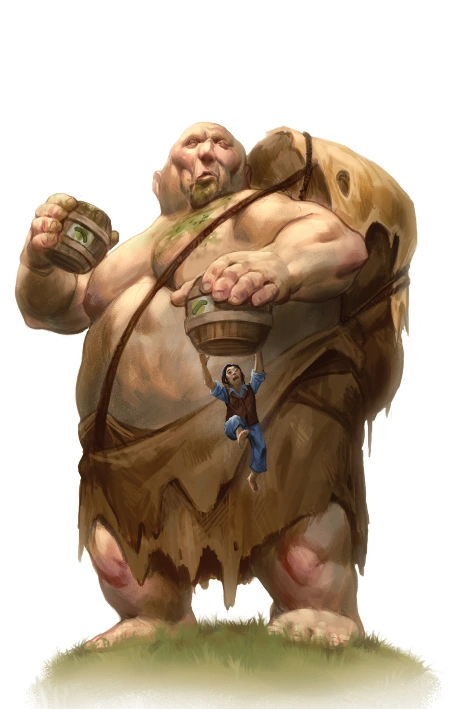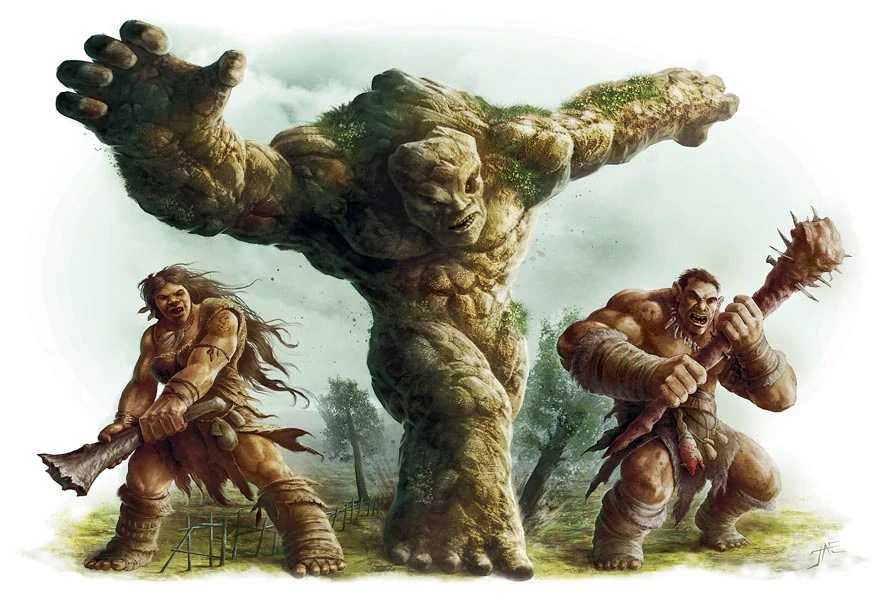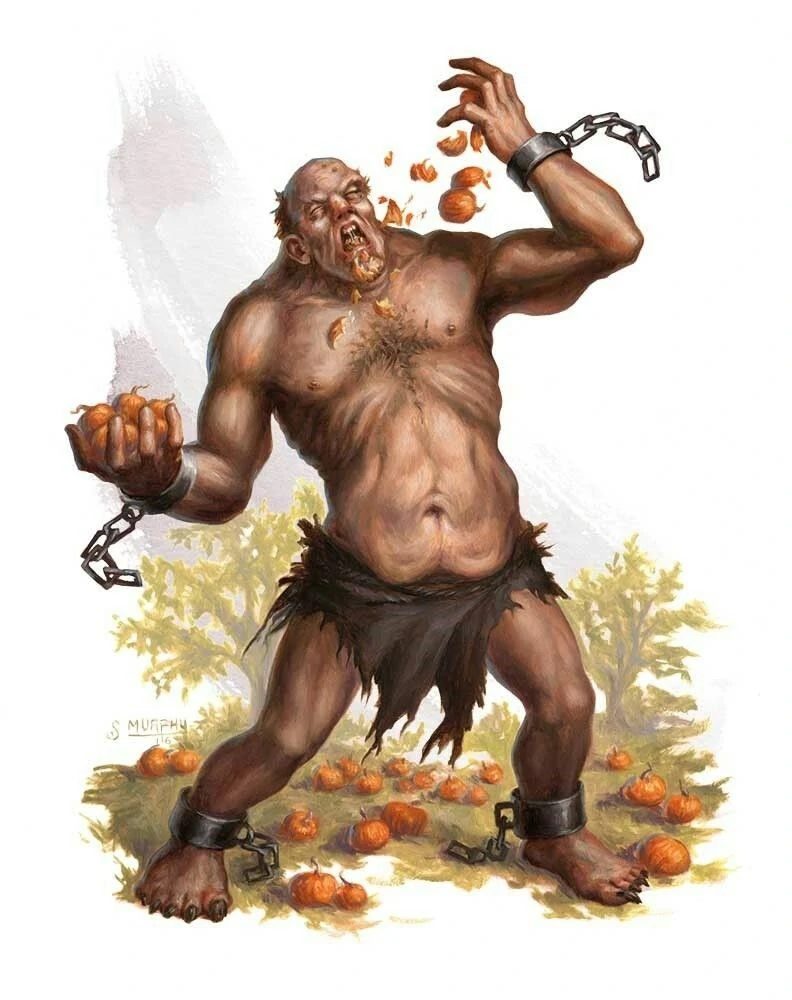Giants are fantastic monsters to throw against a party if you are a Dungeon Master running a low to mid-level party. Their scale makes them a blast to go up against, each type has a fun personality to interact with, and there are few pleasures better than seeing the faces of your party change when you put a massive miniature on the table in front of them
So, if you’re a party that needs a cinematic fight to mix things up or keep them on their toes, you’ll want to throw them up against a Hill Giant. Here’s the bottom line of our Hill Giant 5e guide:
Key Info Up Front
Hill Giants have the lowest Challenge Rating of any giants in DnD of only five. They are also a highly dim-witted species, making them an excellent encounter for lower-level parties.
Their size is unusual for a Challenge Rating that low, so using a Hill Giant for your party’s first encounter with a Huge-sized creature is always a good time.
Hill Giant History in DnD
Hill Giants were first introduced in the first edition of DnD, and they’ve continued to be present in the main monster compendiums of every edition since. Throughout the editions, they have remained essentially unchanged.
This has made them an iconic part of the game’s world, and nearly every longtime player has at least one or two stories about when they first came across a Hill Giant lumbering in the wilds outside of a town or lurking in the shadows of a mountain.
However, one of my favorite parts of Hill Giants is their history and place in the Forgotten Realms. Like all giants, the lineage of the Hill Giants can be traced back to Annam All-Father and his wife, Other.
The two ancient giants had numerous children, which they used to build the giant kingdom of Ostoria. Across the kingdom, they gave each of their children a particular domain to rule, which saw them adapting to their surroundings and becoming the first of each species of giants.
The first Hill Giant was named Ruk, who was given lands of rolling hills to rule over. However, as the Hill Giants grew in number and strength, they would travel across the realm, bullying smaller creatures and taking jobs as bodyguards or soldiers in exchange for food.
In the beginning, Hill Giants were also quite smart. They were known to create great wonders of construction and engineering, such as a stone monument that would display shadows of different animals on the ground at different times of the day.
However, it is believed that the Hill Giants eventually split because of a civil war within their ranks. This saw the creation of the modern Hill Giants and Mountain Giants. Hill Giants tend to be larger but far more dim-witted than their smarter and stronger Mountain Giant peers.
Hill Giants in 5e
In 5th Edition of D&D, Hill Giants are lumbering fools whose aggression is dwarfed only by their appetite. This makes them a blast to play as a Dungeon Master. I can personally vouch for how fun it is to roleplay a foolish giant that is quick to grow angry and bring out some initiative rolls. However, their primitive nature also leads to great worldbuilding opportunities for DMs.
For instance, Hill Giants live in small communities that follow a hierarchy based solely on size and strength. They don’t formally recognize their hierarchy, but each Hill Giant knows that if another Hill Giant or creature is bigger than them, they should do what they’re told.
Their limited intelligence also makes them easily manipulated or directly controlled by other giants, so it can be fun to have a village of Hill Giants under the control of a different giant, creating a neat little plot arc for you to take a party of adventurers through.
Hill Giants are also driven primarily by their appetite and laziness. Their main goals throughout life are to eat as much as they can while doing as little work as possible. Their skin is usually tanned and dry from basking in the sun and not doing anything all day, and they rarely equip themselves with more than a loincloth and uprooted tree because anything else would take too much effort.
This means that any party who takes the time to observe and understand a Hill Giant can be easily manipulated or controlled through bribery or offerings, opening up ways for players to overcome encounters without resorting to violence.
One of the very best parts of Hill Giants, in my opinion, however, is that they don’t have much of a culture of their own. Because of this, they tend to copy the cultures of other creatures that they observe before eating them.
I’ve used this numerous times throughout campaigns both for comedic effect and to create exciting encounters and locales. For example, I had one group of Hill Giants who had observed a group of local Gargoyles and were destroying villages in their search for a roof that could support their weight long enough to perch on it.
Hill Giant Stats
Hill Giants rely entirely on their strength and size to get by. Where they lack brains, they make up for their ability to crush things with a single hit. Their size also grants them a sizable health pool of 105 hit points, which is on the upper end of the range for Challenge Rating 5 monsters. However, that size does come with the drawback of a pitiful Dexterity stat of only 8, giving them a -1 modifier to any related skills.
Other than Strength and Constitution, the rest of a Hill Giant’s stats are similarly low. They come with a Wisdom of only 9 (although their Perception checks are made with a +2 modifier), their Charisma is a 6, and their Intelligence is an abysmal 5. Hill Giants also only speak the Giant language, so if nobody in the party knows how to speak it, talking their way past a Hill Giant won’t be an option.
Hill Giant Abilities
The Hill Giant excels in actions that can put up some seriously scary damage numbers where it suffers in stats. Any party facing a Hill Giant for the first time will quickly learn just how serious scuffling with one of them is, thanks to its two forms of attack that make them lethal at any range.
Their first ability is throwing a large boulder with a minimum range of 60 feet and a maximum of 240. Their throw comes with a +8 hit modifier and deals 3d10 + 5 bludgeoning damage on a successful hit. A maximum of 35 damage is nothing to joke about, especially at level 5. The Hill Giant’s strength ensures that they will likely be able to throw multiple at an enemy before they get close enough to distract it with melee combat.
However, once a Hill Giant is engaged in close-quarters, they only get more capable. This is through their Greatclub action that also comes with a +8 hit modifier. On a successful hit, the Greatclub only deals 3d8 + 5 damage, but they can use two every turn through their Multiattack.
One great way to catch your party off-guard with a Hill Giant during combat is to surprise them with their Greatclub’s reach of 10 feet. Hitting a party member who thought a square between the miniatures meant they were safe is a great way to get across just how massive a creature they are up against.
Playing a Hill Giant
Hill Giants in Combat
When you decide to throw a Hill Giant at your party of adventurers, it all comes down to how you play them. I recommend leaning heavily into the Hill Giant’s nature as a lumbering and foolish bully to give the encounter the most impact. This helps provide them with a unique personality for the setting and is a fun contrast to the Hill Giant’s immense size and potential damage.
One big part of clearly illustrating a Hill Giant’s personality is showing how driven by emotion they are. Have them frequently holler throughout the battle, especially when they attack. If they take a lot of damage from a single hit, you can make them cry like a baby or get even angrier at the inconvenience.
I also tend to have them insulted at losing face by being defeated by smaller beings, especially if a party member can speak Giant and understand the Hill Giant’s mad ramblings during the encounter.
You should also make sure not to make the Hill Giant use too many tactics or brains during the fight. Have them act on instinct by attacking whichever character damaged them last or whoever dealt the most damage to them in the previous round. This is also a convenient tool if the encounter is proving a bit too difficult for your party and you want to scale it back a bit.
Having a Hill Giant furiously charge from one party member to the other with their movement speed of 40 feet is an organic way to push the scales in your party’s favor by giving them numerous free Attacks of Opportunity.
You can also use Hill Giants as an environmental encounter by placing a few on top of cliffs overlooking a valley below. Then, when the party arrives, describe how the valley floor is extremely uneven and battered, almost like a field bombarded in a war.
Describe how the area is also filled with bones and carcasses, and then, if the party doesn’t heed the warning or has no choice but to go through, have the Hill Giants start raining boulders down from above for a fun environmental encounter that can keep things exciting without the need for a lengthy combat encounter.
Hill Giants Outside of Combat
If your party is spying on Hill Giants or manages to communicate with one, you should emphasize their limited intelligence and bully-ish personality. If the party is talking to them, you can have the Hill Giant quickly grow angered or make empty threats to try and get its way.
You could also have it not understand certain words that the players use or frequently ask for them to break concepts and sentences down into simpler and simpler parts to help the Hill Giant understand them. You’ll also need to keep in mind that the Hill Giant’s primary concern should always be where his next meal is coming from.
When you have a party just observing a Hill Giant or a group of them, you’ll have to use slightly more subtle techniques to get their personality across. Thanks to how cartoonish their temperaments tend to be, however, this is thankfully on the more accessible side to do.
I like having small interactions between a couple of Hill Giants ready to go to do this. They don’t have to be anything complicated but can be basic things like two Hill Giants arguing over a scrap of food, one being too lazy to move slightly to grab something they want, or one having a hard time getting up when laying on their back.
If you have a slightly more advanced Hill Giant community in your setting, you can also have one or two of them interact with smaller creatures like Goblins or Dire Wolves that they have done their bidding. Just make sure to make them look like bullies in that interaction.
FAQs
Question: How tall is a Hill Giant in Dungeons and Dragons?
Answer: Hill Giants are classified as Huge creatures, and they are around 16 feet tall.
Question: What is the biggest Giant race in Dungeons and Dragons?
Answer: The largest of all the Giants are the Storm Giants, reaching up to 26 feet fall.
Question: Can players play as a Hill Giant in Dungeons and Dragons?
Answer: Since it’s DnD, this is primarily up to the game’s Dungeon Master, although having a player character that is a Hill Giant will bring some major complications that need to be accounted for throughout the campaign. There are also no specific attributes for a Hill Giant PC in 5e, but there was an official block released in 3.5e that can easily be converted over.
Conclusion
One of the best parts of DnD is how players can mold and manipulate its various components in ways that only they can create unique and exciting interactions between them. Hill Giants are no different, and there are a ton of great ideas that they can be used for. Maybe a Hill Giant chieftain is more intelligent than the others and is beginning to combine tribes into a larger, more dangerous presence.
Maybe a group of Hill Giants has grown jealous of a peaceful village’s existence, and the party has to help convince the village to allow the Hill Giants to join their community peacefully. Whatever you decide to do with them, they are an impactful presence in the Forgotten Realms, and there are countless ways they can leave an impression on your party.
- Steel Defender 5e Guide - September 5, 2022
- Harengon 5e Guide - August 24, 2022
- Shambling Mound 5e Guide: The Most Terrifying Plant - August 21, 2022






